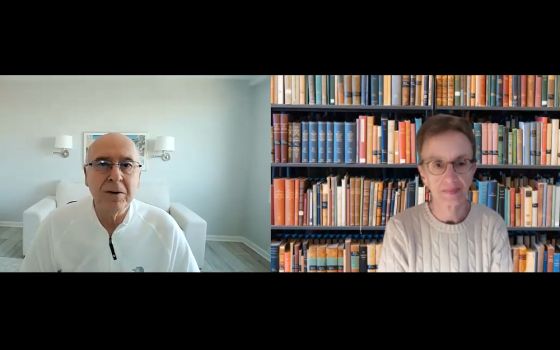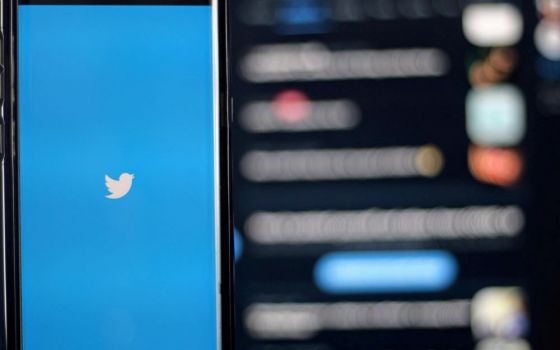A young man holds a crucifix as he and other immigrants attend Mass on the U.S. side of the border in El Paso, Texas, Feb. 17, 2016. (CNS/Nancy Wiechec)
Editor's note: This Lent, NCR will host live spiritual conversations every other week, hosted by our Soul Seeing editor, Michael Leach. Today, join Natalia Imperatori-Lee at 1:30 p.m. Central/2:30 p.m. Eastern live on YouTube and Facebook for a conversation about Lent during a time of pandemic. The videos will also be recorded for viewing after the event. Check the Soul Seeing for Lent series page for links to past conversations.
Have we decided yet? Is this "Lent, Again?" Or is it "Lent, Still?"
The past year has demonstrated a strange elastic quality about time. Time drags but it also passes in a heartbeat. In the odd existence that the last 12 months have provided us, time has seemed increasingly malleable. We don't go anywhere so all the days look the same. Every day seems like the other, weekdays blend into weekends. The global COVID-19 pandemic has us in a near-constant state of vigilance, anxiety and depression as we witness unparalleled loss, unprecedented strangeness.
And yet, as we see the month of March looming on the calendar, it seems difficult to believe. Where did the year go? How is it March now, when our lives have basically been stuck in some variation of March 2020 for 11 months already? Whatever else we can say about the period between Lent 2020 and Lent 2021, we know it's been a weird one.
One "perk" of this time period is that I now share home office space with my son, a sophomore in high school. I get to overhear his (prolific) class participation, and I get a window into how high school boys are learning these days (loudly?).
Advertisement
For example, they are learning the subjunctive mood in Spanish class. When I learned, as a native speaker, how to render a verb in the subjunctive, we had a simple prompt that would elicit the correct conjugation: mi mama quiere que yo ... ("my mom wants me to …"). With my son, who is learning Spanish mostly from scratch, the process is far more complex.
The subjunctive mood isn't really a thing in the English language — we rely far more on the indicative, which normally points to what is or can be perceived. The subjunctive is different. It is restricted in Spanish to dependent clauses, and is useful when expressing things like expectations (maternal or otherwise), doubts, demands and advice.
My son's Spanish teacher taught them a fantastic acronym for this: WEIRDO. That is, use the subjunctive for Wishes, Emotions, Impersonal expressions, Recommendations, Doubt/Denial, and Ojalá (kind of like "hopefully").
I move that we declare this Lent a WEIRDO season.
I have my reasons. First, this Lent is indisputably weird. The thought of sacrificing something for Lent after a year of sacrificing social connection, in-person schooling, grandparent hugs, Thanksgiving and Christmas with family, and even dinner at a restaurant seems ridiculous. We are already sacrificing, and so many others have sacrificed so much more: lives and livelihoods, homes and businesses, health and safety. What more can we give up? We've stripped our lives of routines, relationships and all manner of habits that supported our mental and communal health, and (most of us) have done it willingly, for the good of others.
Isn't that Lenten sacrifice enough?
Lent also represents an in-between time. Jesus takes to the desert in the period between his baptism and his public ministry. He goes there to gather himself, to prepare for a public future that looks different from his life until then.
The sun sets behind a desert view in the Spur Cross Ranch Conservation Area in Cave Creek, Arizona. Lent also represents an in-between time. Jesus takes to the desert in the period between his baptism and his public ministry. He goes there to gather himself, to prepare for a public future that looks different from his life until then. (CNS/Nancy Wiechec)
The COVID-19 pandemic has also created an in-between-ness, lifting a veil on our reality. This is fitting, since so many of us feel like this is an apocalyptic time, and apocalypse and revelation are synonymous — to live in apocalyptic times is to see past the veil of our comfortable illusions. We have seen the vast disparity between rich and poor, between Black and non-Black lives, between whose work is essential to the functioning in our society and whose is merely paid as if it were.
And here we sit, in between a 2019 world, where we were ignorant (willfully or not) of these realities, and 2022, when we will "return to normal." But do we want to return, and can we? Or will we use this in-between time to reset our priorities, to create new patterns of relationality, to embolden our communities to enact justice? Pope Francis has certainly encouraged us to emerge from the pandemic confinement with new commitments to combat climate change, poverty and racism.
We can, and must, emerge from this desert willing to live, teach, love one another differently. Theologian Roberto Goizueta wrote, in an essay entitled "Fiesta: Life in the Subjunctive," that the subjunctive mood has something to say about our way of living, because it is about the "ability to evoke future possibilities between a remembered past and a hoped-for future."
Reflecting on Latinx, and specifically Mexican-American, traditions of fiesta, Goizueta's essay reminds us that not all cultures see humans fundamentally as doers/makers first. Rather, for him and for other Latinx theologians, human beings are enmeshed in a web of interdependent relationships. The subjunctive allows us to express this dependency and our identity as recipients of the gift of life. Rather than a mere "attitude of gratitude" (a cliché these days), for Latinx theology this expression of fundamental dependence is countercultural. He writes:
to celebrate life as gift in the midst of a culture that views life as an object to be controlled is a prophetic act; to "waste" time celebrating in the midst of a culture where time is a priceless commodity … is a subversive act.
This weirdo Lent has found us in the interstices between a remembered past and a hoped-for future, and has thereby given us a chance to experience ourselves as dependent on others and on God. This Lent we might imagine change, be countercultural, on a bigger scale than before.
This Lent, I am sitting with all the possibilities of the subjunctive, and I invite you to join me. We can allow ourselves to wish: for a better normal, a more just world and more inner tranquility. We might sit with our emotions and welcome them all, including and maybe especially grief, sorrow, frustration or anger. We should consider which impersonal expressions (one-ought-to's) are worthy of our attention and which of these expectations can be left behind, in the 2019 life. We can plan out recommendations, mapping how we want our collective future to look different from our past.
Here specifically I'm thinking of lessons of incarnation, community and embodied reality that the year has forced us to confront and absorb. We can even leave room for doubt, that oft-maligned but crucial companion on the journey of faith. We can and should, recalibrate our notions of "wasting time."
In the desert, Jesus is tempted to choose an easy life filled with riches and adulation, but he chooses to follow a far more difficult path that will remake the world. Will we do the same? Ojalá.








